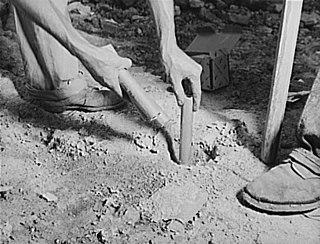
Dynamite is an explosive made of nitroglycerin, sorbents, and stabilizers. It was invented by the Swedish chemist and engineer Alfred Nobel in Geesthacht, Northern Germany, and was patented in 1867. It rapidly gained wide-scale use as a more robust alternative to the traditional black powder explosives. It allows the use of nitroglycerine's favorable explosive properties while greatly reducing its risk of accidental detonation.

An explosive is a reactive substance that contains a great amount of potential energy that can produce an explosion if released suddenly, usually accompanied by the production of light, heat, sound, and pressure. An explosive charge is a measured quantity of explosive material, which may either be composed solely of one ingredient or be a mixture containing at least two substances.

Nitroglycerin (NG), also known as trinitroglycerol (TNG), nitro, glyceryl trinitrate (GTN), or 1,2,3-trinitroxypropane, is a dense, colorless or pale yellow, oily, explosive liquid most commonly produced by nitrating glycerol with white fuming nitric acid under conditions appropriate to the formation of the nitric acid ester. Chemically, the substance is an organic nitrate compound rather than a nitro compound, but the traditional name is retained. Discovered in 1846 by Ascanio Sobrero, nitroglycerin has been used as an active ingredient in the manufacture of explosives, namely dynamite, and as such it is employed in the construction, demolition, and mining industries. It is combined with nitrocellulose to form double-based smokeless powder, used as a propellant in artillery and firearms since the 1880s.

C-4 or Composition C-4 is a common variety of the plastic explosive family known as Composition C, which uses RDX as its explosive agent. C-4 is composed of explosives, plastic binder, plasticizer to make it malleable, and usually a marker or odorizing taggant chemical. C-4 has a texture similar to modelling clay and can be molded into any desired shape. C-4 is relatively insensitive and can be detonated only by the shock wave from a detonator or blasting cap.

A skyrocket is a type of firework that uses a solid-fuel rocket to rise quickly into the sky; a bottle rocket is a small skyrocket. At the apex of its ascent, it is usual for a variety of effects to be emitted. Skyrockets use various stabilisation techniques to ensure the flight follows a predictable course, often a long stick attached to the side of the motor, but also including spin-stabilisation or fins.

The National Firearms Act (NFA), 73rd Congress, Sess. 2, ch. 757, 48 Stat. 1236 was enacted on June 26, 1934, and currently codified and amended as I.R.C. ch. 53. The law is an Act of Congress in the United States that, in general, imposes an excise tax on the manufacture and transfer of certain firearms and mandates the registration of those firearms. The NFA is also referred to as Title II of the federal firearms laws, with the Gun Control Act of 1968 ("GCA") as Title I.

The Bureau of Alcohol, Tobacco, Firearms and Explosives (BATFE), commonly referred to as the ATF, is a domestic law enforcement agency within the United States Department of Justice. Its responsibilities include the investigation and prevention of federal offenses involving the unlawful use, manufacture, and possession of firearms and explosives; acts of arson and bombings; and illegal trafficking and tax evasion of alcohol and tobacco products. The ATF also regulates via licensing the sale, possession, and transportation of firearms, ammunition, and explosives in interstate commerce. Many of the ATF's activities are carried out in conjunction with task forces made up of state and local law enforcement officers, such as Project Safe Neighborhoods. The ATF operates a unique fire research laboratory in Beltsville, Maryland, where full-scale mock-ups of criminal arson can be reconstructed. The ATF had 5,285 employees and an annual budget of almost $1.5 billion in 2021. The ATF has received criticism over its handling of the Ruby Ridge siege, the Waco siege and other incidents.

A firecracker is a small explosive device primarily designed to produce a large amount of noise, especially in the form of a loud bang, usually for celebration or entertainment; any visual effect is incidental to this goal. They have fuses, and are wrapped in a heavy paper casing to contain the explosive compound. Firecrackers, along with fireworks, originated in China.

In the United States, a gun show is an event where promoters generally rent large public venues and then rent tables for display areas for dealers of guns and related items, and charge admission for buyers. The majority of guns for sale at gun shows are modern sporting firearms. Approximately 5,000 gun shows occur annually in the United States.
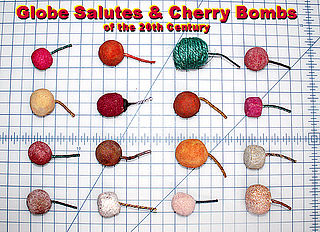
A cherry bomb is an approximately spherical exploding firework, roughly resembling a cherry in size and shape. Cherry bombs range in size from three-quarters to one and a half inches in diameter.

Fireworks in England, Scotland and Wales are governed primarily by the Fireworks Regulations 2004, the Pyrotechnic Articles (Safety) Regulations 2015, and British Standards BS 7114 until 4/7/17 and BS-EN 15947-2015. In Northern Ireland, fireworks are governed by The Pyrotechnic Articles (Safety) Regulations 2015, and Explosives (Fireworks) Regulations (NI) 2002.
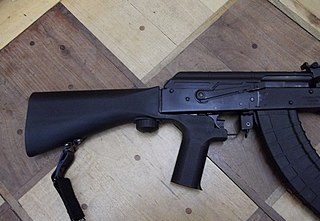
Bump stocks or bump fire stocks are gun stocks that can be used to assist in bump firing, the act of using the recoil of a semi-automatic firearm to fire cartridges in rapid succession.

Short-barreled rifle broadly refers to any rifle with an unusually short barrel. The term carbine describes a production rifle with a reduced barrel length for easier handling in confined spaces. Concern about concealment for illegal purposes has encouraged regulations specifying minimum barrel lengths and overall lengths.
In the United States, the right to keep and bear arms is modulated by a variety of state and federal statutes. These laws generally regulate the manufacture, trade, possession, transfer, record keeping, transport, and destruction of firearms, ammunition, and firearms accessories. They are enforced by state, local and the federal agencies which include the Bureau of Alcohol, Tobacco, Firearms and Explosives (ATF).

Title II weapons, or NFA firearms, are designations of certain weapons under the United States National Firearms Act (NFA).

M-80s are an American class of large powerful firecrackers, sometimes called salutes. M-80s were originally made in the mid 20th century for the U.S. military to simulate explosives or artillery fire. The "M" is designated by a U.S. military convention for "standard" equipment and "80" is for the 80 grains of flash powder within it. Later, M-80s were manufactured as consumer fireworks made from a small cardboard tube, often red, approximately 1+1⁄2 inches (3.8 cm) long and 9⁄16 inch (1.4 cm) inside diameter, with a fuse coming out of the side; this type of fuse is commonly known as cannon fuse or Visco fuse, after a company responsible for standardizing the product. The consumer version holds a reduced charge of 45 grains of pyrotechnic flash powder.
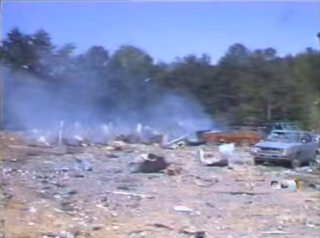
The Benton fireworks disaster was an industrial disaster that occurred on May 27, 1983, on a farm near Benton, Tennessee. A powerful explosion at an unlicensed fireworks factory producing illegal fireworks killed eleven and injured one, revealing the existence of the factory for the first time to law enforcement and the public. The initial explosion was heard more than 20 mi (32 km) away.
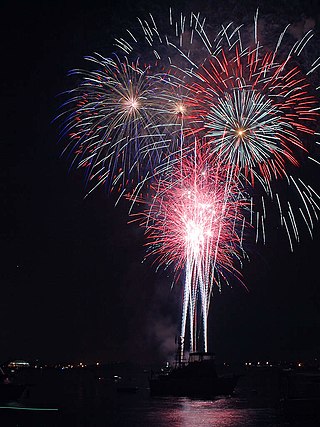
Fireworks policy in the United States can be different in each jurisdiction.

A privately made firearm, also called a ghost gun or homemade firearm, is a firearm made by a private individual, in contrast to one produced by a corporate or government entity. The term "ghost gun" is used mostly in the United States by gun control advocates, but it is being adopted by gun rights advocates and the firearm industry.

M-100s are a class of powerful firecrackers commonly called salutes.



















